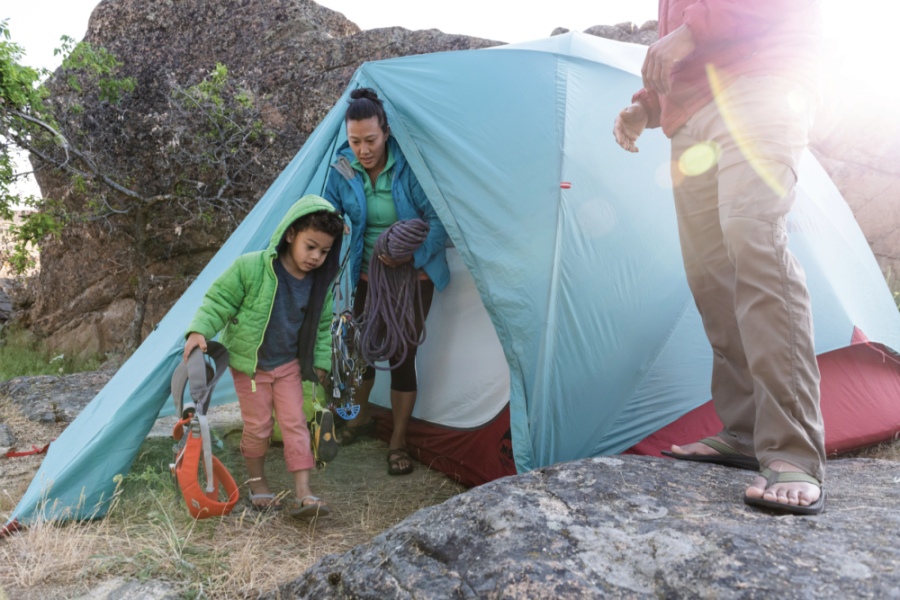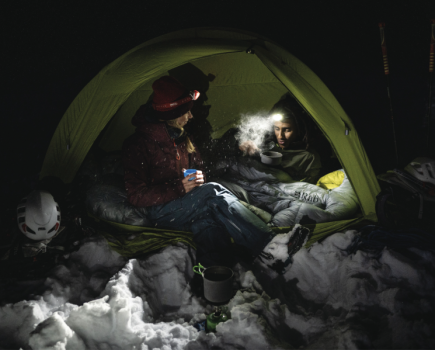The broad family tent market encompasses perhaps the widest variety of models in the outdoor sector. Prices range from a few hundred to a few thousand pounds. Huge, weighty models offer internal space, multiple bedrooms and necessitate large vehicles for transportation along with all the associated furniture and accessories – inflatable mattresses, inflatable sofas, dining tables, toys, gas stove and barbeques come to mind – that some families might demand.
Main image: The MSR Habitude 6 offers a base camp for adventure | Credit: Scott Rinckenberger
At the other end of the scale are tents light and small enough to split between family members for proper adventures; while boasting fewer comforts, they offer the advantages of freedom, fresh air and open spaces associated with backpacking.
Between those two extremes lie basecamp-type structures, group shelters for multiple occupants, and more modest family-friendly models built to a budget – probably the bulk of models in the family camping genre. Most are too heavy to be borne in backpacks and are more likely to be transported by car or van, porter or even yak.
Considerations might include budget, group or family size and privacy needs: teenagers are more likely to demand their own bedrooms than toddlers, adding weight and cost to the model selected. Accessories might also play a factor: to take advantage of the electric hook-ups offered at most campsites, for music or lighting perhaps, you’ll need cable entry points. If you want luxuries such as inflatable sofas and dining tables, you’ll need a vestibule big enough to accommodate them.
If you want a backpacking tent, you’ll need to compromise on space and privacy, and find a model light enough to split between willing party members. And any tent accommodating four or more people will need good ventilation to cope with the amount of condensation their combined breathing will produced.
Why you can trust The Great Outdoors
The Great Outdoors is here to help you make the most of your time outside. We have been helping people to explore from sea to summit, valley to mountain top for over 40 years. Our gear tests remain completely impartial. If you are wary of websites that only review brands that advertise with them, or sceptical of social media accounts always singing the praises of their latest freebie, you’ve come to the right place! Our reviews rank #1 for rigour, trustworthiness, and independence, and our gear testing team is the most experienced in Britain. With over 200 years’ experience between us, we are professional mountain leaders and instructors, wildlife photographers and rangers, outdoor authors, guidebook writers and trail addicts. Find out more about how we test.
The best family tents we’ve reviewed
We’ve also looked at the best one-person tents for backpacking and two-person tents if you don’t need the extra space a group tent offers. For those on a budget, here’s a round up of the best value tents we’ve tested.
| Quick List |
|---|
| Lightest in Test: Robens Pioneer 4EX (available from Decathlon) |
| Best for space: Coleman Weathermaster 4XL Air (available from Outdoor Action) |
| Best for basecamp: MSR Habitude 6 (save 47% at Blacks) |
| Best value: Outwell Earth 4 (available from Cotswold Outdoor) |
Lightest in test
Robens Pioneer 4EX
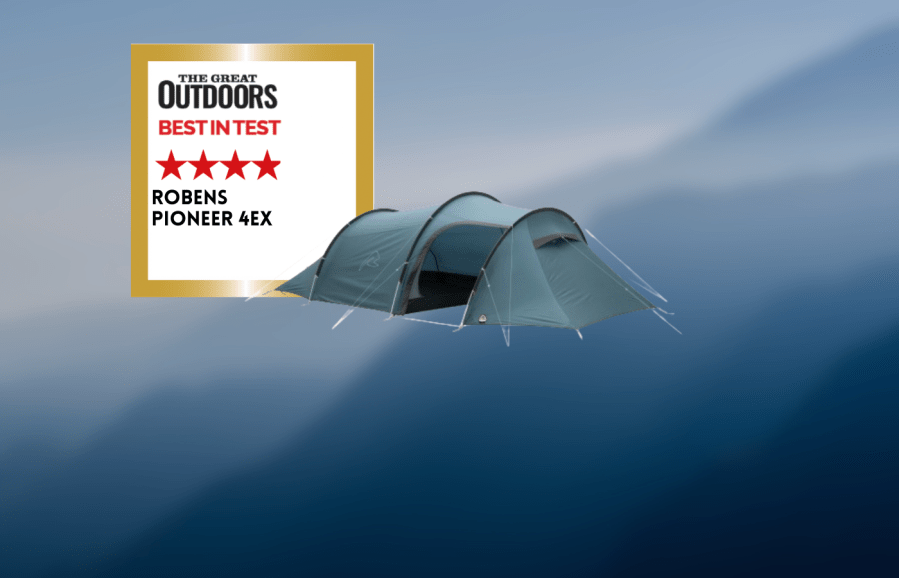
John Manning’s Best In Test
I’m drawn to the Pioneer 4EX, as the most backpackable family tent. It’s affordable, the build quality is great and, at 3.8kg, it’s the lightest of those tested.- Weight
- Price
- Fly first or single unit pitching
- Porch groundsheet not supplied
- Limited space for festering
- Pitching as unit or outer first
| Quick specs |
|---|
| Price: $357 / £264.99 Weight: 3.8kg Berth: 4 Flysheet: HydroTex Core, 75D polyester 190T, 3,000mm HH Inner: 68D polyester 190T, breathable polyester Groundsheet: 75D polyester Taffeta 185T PU coated, 6,000mm HH Poles: Aluminium 7001, T6, 9.5 mm, anodised Pegs: 19 x round alloy pegs Porch (tapers): W: 230/190cm, L: 175cm, H: 120/105cm (Roben’s measurements) Bedroom (tapers): W: 210/175cm, L: 220, H: 100/90cm (Robens’ measurements) Overall inner dimensions: W: 220cm, L: 210cm, H: 120cm (Robens’ measurements) www.robens.co.uk |
The Pioneer 4EX family tent is a simple single porch-and-bedroom tunnel affair. It arrived packed to pitch fly-first – which is helpful in bad weather – but will pitch as a single unit – which is great in bad weather.
Steph and I had the Pioneer 4EX up in under five minutes, making this the fastest pitched of the tents tested. Three similarly sized poles – thankfully colour coded – slip through sleeves to be secured in pockets at the far end, and grommets at the near. Of the 19 light alloy stakes supplied, we found five necessary for a minimum pitch on a still evening with a kind weather forecast; with all eight guy-lines pegged out, and every staking point used, all 19 stakes were deployed, making this a sound, rigid shelter.
The bedroom, which is well-ventilated with mesh panels in the upper sections of the back wall and the door, provides a snug fit for four people, with a small amount of space for gear at the feet, meaning the good-sized porch is going to be the prime gear storage area. I’m drawn to the Pioneer 4EX, as the most backpackable family tent. It’s affordable, the build quality is great and, at 3.8kg, it’s the lightest of those tested, comfortably splitable between two people (or four, if the kids can be bribed with ice cream) for a family backpacking adventure.
Read more: John’s full Robens Pioneer 4EX Review
Best for space
Coleman Weathermaster 4XL Air

John Manning Recommends
I’d been wary of this type of tent but was bowled over by the Weathermaster 4XL Air’s easy, speedy pitch and its luxurious roominess.- Space
- Black-out bedroom
- Speedy all-in-one pitch
- Weight
- Packed size
| Quick specs |
|---|
| Price: $1,078 / £800 Weight (g/kg): 30.4kg (31.9kg inc pump) Berth: 4 Pitching: As a unit Flysheet: PU-coated polyester, 4500mm HH Inner: Breathable polyester and PU-coated polyester on Blackout bedrooms; No-see-um mesh Groundsheet: PE, welded, fully integrated with rainskirts Poles: Inflatable Fast Pitch Air poles (pump included) Pegs: 46 (4 x V-shape corner stakes; 21 x plastic T-shape stakes; 18 wire stakes; 3 x wire loops stakes) Porch: W: 300cm, L: 170cm (approx); vestibule: W: 300cm, L: 270cm (approx) Bedrooms: Two – W: 140cm Overall inner dimensions: W: 310cm, L: 665cm, H: 215cm www.colemanuk.co.uk |
If tempted by this spacious Weathermaster 4XL Air family tent, ensure you’ve room in your vehicle: its packed dimensions are a boot-busting 80cmx60cmx42cm (approx). It weighs over 30kg, arrived on a pallet, its reinforced carrybag has wheels… it’s a big tent.
This was my first experience of inflatable “poles”. The five Fast Pitch Air technology poles each needed inflating to around 7psi: the supplied handpump’s pressure gauge prevents over-inflation. Coleman says the tent – which goes up as one unit – can be erected single-handed: working as a pair, it went up surprisingly quickly and easily, a big plus in rain as it results in less moaning from impatient younger family members. Despite there being no breeze, we pegged out all the guys for a much more rigid pitch.
The vestibule easily accommodates dining table and chairs, or kids’ toys. Cable access points either side accommodate electric hook-up, with internal Velcro loops to guide cables to where you need them. Six mesh pockets between the doors to the bedrooms are useful for stashing belongings. Mesh ceilings reduce condensation, and each bedroom has two-way zipped access to rear external vents, mesh pockets in the walls and single hanging loops. The dividing wall unzips to create a larger sleeping area for four, if required.
I’d been wary of this type of tent but was bowled over by the Weathermaster 4XL Air’s easy, speedy pitch and its luxurious roominess.
Read more: John’s full Coleman Weathermaster 4XL Air Review
Big Agnes Wyoming Trail 4
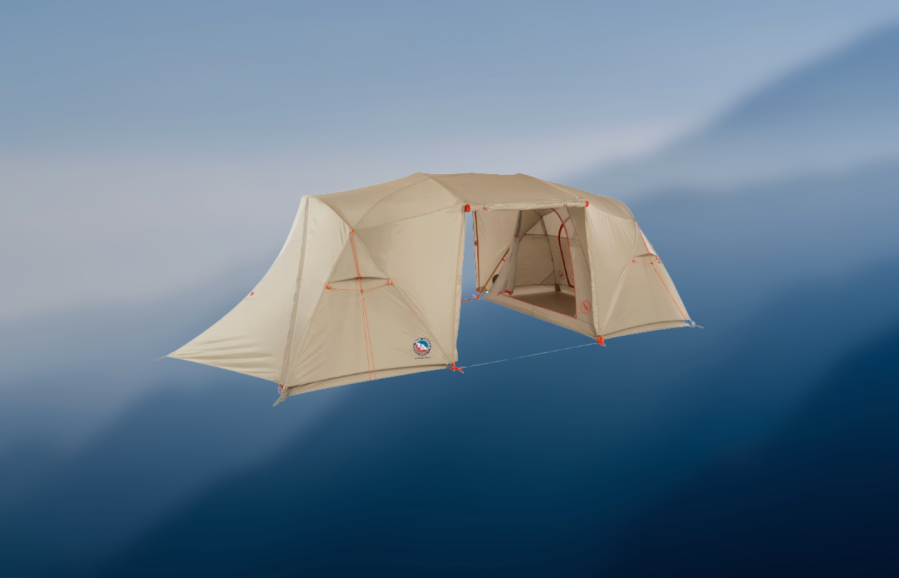
John Manning’s verdict
Though fiddly to erect – perhaps best handled by two – the well-made Wyoming Trail 4 offers great rigidity and a generous vestibule with good headroom, as a family or group base camp.- Overall inner space
- Height
- Integrity
- Ventilation
- Twin porches
- Backpack style carrybag
- Inner-first pitch
- no references to colour coding in instructions
- Small bedroom
- pole sections detached during erection;
- narrow porches and bedrooms
- Price
| Quick specs |
|---|
| Price: $499.98 / £1,100 (does not include footprint) Weight: 10.12kg Berth: 4 Pitching: Inner-first pitching (unless using optional footprint) Flysheet: Polyester taffeta with a 1500mm waterproof polyurethane coating Inner: Breathable polyester taffeta and mesh Groundsheet: Polyester taffeta with a 1500mm waterproof polyurethane coating Poles: DAC lightweight aluminum Pegs: 14 x 19cm red alloy Dirt Bagger stakes Porches: Two porches – L: 86cm at deepest point, W: 229cm, H: not applicable Vestibule – L: 170cm, W: 229cm, H: 178cm Bedroom dimensions: Two – each L: 137cm; W: 229cm, H: 54cm Overall dimensions: L: 617cm, W: 229cm, H:178cm at apex eu.bigagnes.com |
Following meticulous 20-point instructions, the Wyoming Trail 4 family tent took half-an-hour to erect solo – with a few expletives. It’s designed as an inner-first pitch and has inner mesh ceilings, so not best-suited to foul weather pitching. It comprises two 135cm-high bedrooms at opposite ends, linked by ground-level fabric ribbons which define the central vestibule space between. After staking out those bedrooms – the ribbons are essential for placement – two unwieldy poles, each over 6m long, fix to opposing corners and clip together at the apex, above the centre of the vestibule. They are, I suspect, near the limit of the shock-cording’s tolerance: sections separated, occasionally after insertion into the pole sleeves, which was fiddly to fix. Two shorter, better-behaved poles supported the tent’s ends. With everything clipped together, rigidity increased and fiddliness decreased.
The bedrooms hooked on to that pole structure, each requiring 12 Velcro tabs and clips. The flysheet then spanned all three areas, leaving small porches either end. Two small poles, which added rigidity to the vestibule ceiling, demanded brute strength to slip them into their respective pockets. Four guylines completed the pitch.
The bedrooms seemed a tad small given the erected tent’s length of over 6m and its 229cm width. Their external doors, through the back of each small porch, proved essential, as sleepers lie across the width, rather than depth, so they save stepping over a snoring partner when rising in the night. The porches are okay for gear storage or sitting up in fine weather. Ventilation throughout is excellent: each bedroom has a mesh ceiling and upper door panel, and there are four vents in the fly sheet.
Read more: John’s full Big Agnes Wyoming Trail 4 Review
Best value
Outwell Earth 4
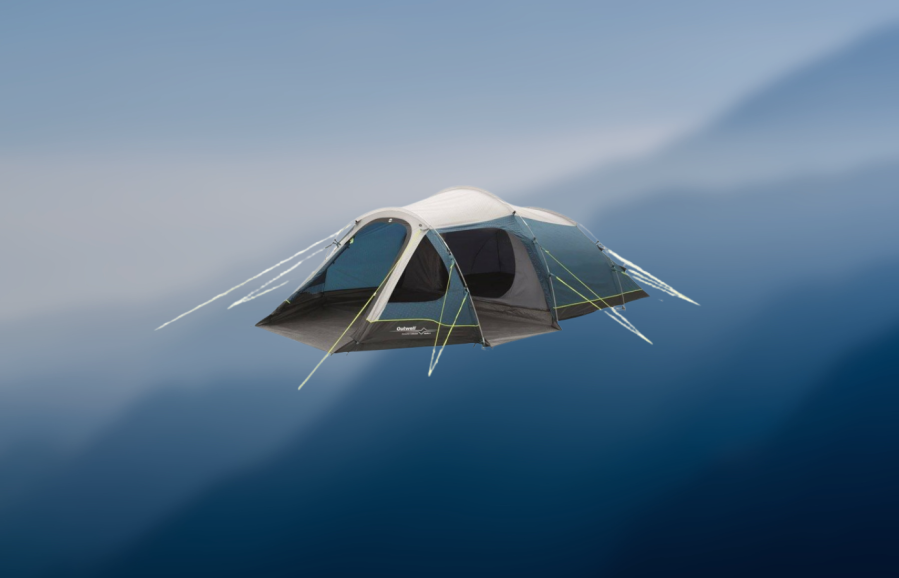
John Manning’s verdict
It’s weighty, too, a major contributor to the fact that this is a heavy tent for its size; nevertheless the Earth 4 represents a good tent for the money.- Blackout bedroom
- Spacious
- Simple
- Ill-fitting groundsheet
- Weight
| Quick specs |
|---|
| Price: $296 / £223.99 Weight (g/kg): 7.4kg Berth: 4 Pitching: Fly-first or as a unit Flysheet: Outtex 3000 Select polyester, 3,000mm HH Inner: Breathable polyester Groundsheet: Double-coated waterproof polyethylene Poles: Duratec fibreglass 9.5 mm Pegs: 23 x 19cm steel Encounter pegs Porch: W: 240cm, L: 200cm, H: 140cm (Outwell measurements) Bedroom dimensions: W: 240cm, L: 210cm, H: 130cm (Outwell measurements) www.outwell.com |
I felt drawn to Outwell’s Earth 4 tunnel family tent, perhaps because it best resembles the backpacking tents with which I’m more familiar. It’s not a backpacking tent, of course: at 7.4kg it’s too heavy to practically split between two for a family hiking trip, and is better suited to car camping; unlike some, it’s small enough for a conventional car boot. We had the three-pole tent up in under ten minutes, straight from the bag. It pitches as a unit or fly-first: of the 23 stakes provided we used five for a minimal pitch; seven minimised fabric sag.
It’s a simple, roomy tent, half-porch, half-bedroom, the latter featuring blackout fabric for (hopefully) a better night’s sleep. Though not as effective as that of the Coleman Weathermaster, we found it better than the Vango Beta 550XL’s (both also reviewed). Bedroom ventilation is good, with a mesh vent in the door and in the rear wall of the sleep compartment, which can be rolled up and fastened back when necessary. That rear vent aligns neatly with a large vent in the fly sheet’s back wall. The bedroom walls also feature storage pockets, as well as loops for lanterns or hanging lines.
I’m a sucker for porches with a groundsheet, which keep gear condensation-free and provide a more comfortable area in which to sit than on bare ground. The Outwell Earth 4’s detachable, double-coated, waterproof polyethylene offering, however, was an awkward fit, and felt as though it might have been designed for another tent: the Velcro tabs with which it attached to the inner door panel seemed poorly positioned. It’s weighty, too, a major contributor to the fact that this is a heavy tent for its size; nevertheless the Earth 4 represents a good tent for the money.
Read more: John’s full Outwell Earth 4 Review
Best for basecamp
MSR Habitude 6
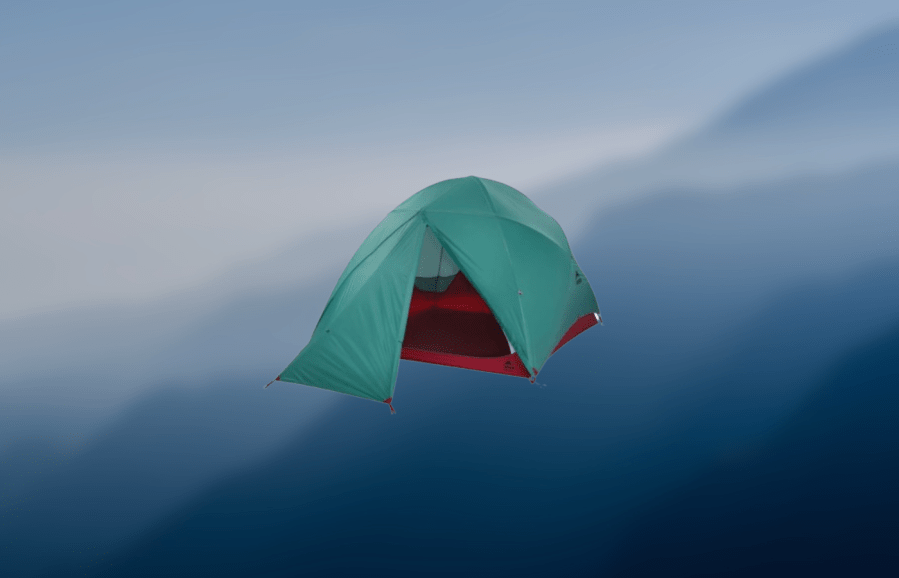
John Manning’s verdict
The Habitude 6 is well-designed and well-made: with no inner space division, it’s one for a close-knit family (beware if you have grumpy teenagers!), familiar friends or use as a basecamp.- Great space to weight ratio
- Well-made
- Quality
- Complex pole systems
- inner first pitch
| Quick specs |
|---|
| Price: $699.95 / £550 Weight (g/kg): 6.35kg (7kg) Berth: 6 Pitching: Inner-first Flysheet : 68D ripstop polyester 1,500mm Polyurethane & DWR Inner: 68D taffeta polyester & DWR Groundsheet: 68D taffeta polyester 10,000mm Polyurethane & DWR Poles: 3x 7000 Series Aluminium, diameter: 11mm Pegs: 9 x MSR Hook tent stakes Porch dimensions: W: 250cm, L: 130cm, H: 170cm (JM’s measurements) Bedroom dimensions: W: 254cm, L: 305cm, H: 195cm (MSR measurements) Overall inner dimensions: W: 254cm, L: 427cm, H: 195cm (MSR measurements) www.msrgear.com |
Seattle-based MSR’s Habitude 6 family tent pitches inner-first, with no single unit-pitch option. I suspect it’s designed with North America’s drier states in mind: the inner’s fine mesh ceiling makes a speedy set-up essential in our damper climate, to avoid the inner getting wet before you can attach the fly sheet.
Fortunately, the well-ventilated Habitude pitches quickly with just nine alloy stakes (stylishly colour-matched to the tent fabric). The tent’s three colour-coded poles are spidery, gangly contraptions (I feared we might put someone’s eye out), each consisting of two shock-corded sectional alloy poles connected at a plastic hub: one spans the apex, while the other two support the opposing sides. Complicated but efficient, it creates a rigid, huge inner space, easily big for four to chill in (the tent’s designed for six). If you’re staking out the supplied guylines, stake use needs to be judicious as all nine supplied are required to pin the tent down; carrying a few spares might be advisable.
That the inner space is fully utilisable is down to the tent’s near-sheer walls: with little sloping fabric, floorspace is maximised. The disadvantage is that the single porch is quite shallow, with barely space to sit in, let alone cook within. While good for a little gear storage, it’s also the tent’s only door, so can’t be blocked. The Habitude 6 is well-designed and well-made: with no inner space division, it’s one for a close-knit family (beware if you have grumpy teenagers!), familiar friends or use as a basecamp on a campground.
Read more: John’s full MSR Habitude 6 Review
Vango Beta 550XL
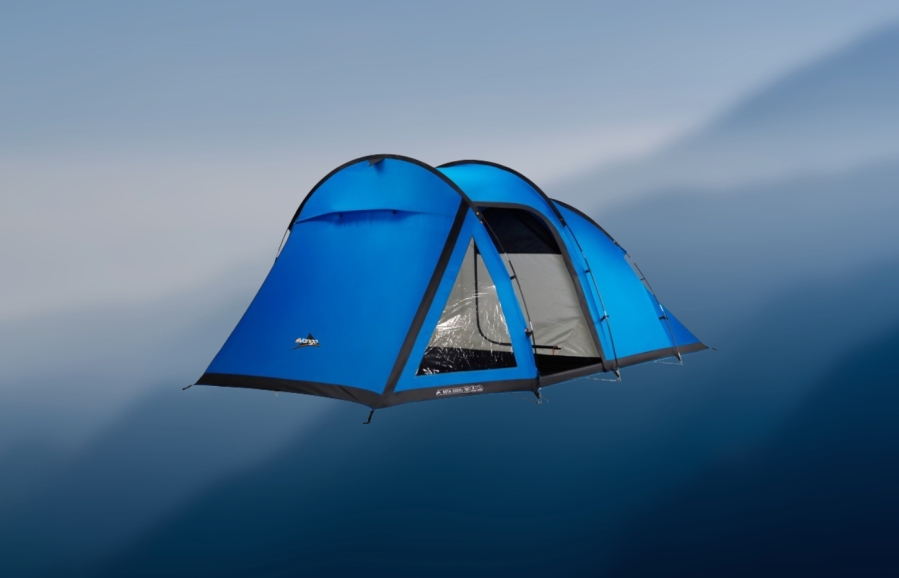
John Manning’s verdict
While offering good value for money at the lower end of the price bracket, the tent was let down by the finish: we found loose threads, and a guyline lacked a crucial plastic ring- Oversized Carry bag
- Roomy
- Tension bands
- Blackout bedroom fabric
- Single-unit pitch
- Poor finishing
- Fiddly tension bands
| Quick specs |
|---|
| Price: $404 / £300 Weight (g/kg): 12.1kg (12.2kg) Berth: 5 Pitching: Fly-first or as a unit Flysheet: 70D Sentinel Fabric, 3,000mm HH, Diamond Clear Windows Inner: Midnight Bedroom darkened fabric Groundsheet: Waterproof PE Poles: PowerFlex Fibreglass Poles Pegs: 21 steel pins Porch: W: 315cm, L: 250cm; H: 200cm (Vango measurements) Bedroom (total): W: 300, L: 210cm, H: 190cm (Vango measurements) Overall inner Dimensions: W: 300cm, L: 475cm, H: 200cm/190cm (Vango measurements) |
The five-berth Vango Beta 550XL family tent is a tad tight for five but impressively wide, and comfortable for four. Pitching, despite its three somewhat long and unwieldy colour-coded poles, took two of us an impressive sub-20 minutes, first time out of the bag. TBS II tension bands at ground level and at the inner door between porch and spacious bedrooms added stability and integrity. Pitching in fine weather with very little breeze, we left most guylines unstaked, using just 16 of the 21 stakes provided. The Beta 550XL arrives detached and pitches fly-first – great in bad weather – and can be left assembled for a speedier, single unit-pitch.
The groundsheet on the Vango Beta 550XL runs through the sizable, brightly lit porch and the well-vented bedrooms. We measured the porch as 320cm wide and 255cm deep (Vango states 315cm wide x 250cm deep): a useful social area, and a practical place for dry gear storage. Its 190cm height (Vango states 200cm) is sufficient for most folk to stand within.
Outer doors slope inward gently from the ground-up but have no protective top lip. While we tested it in fine weather, I’d worry that rain would land within the porch as people open the door to enter and exit. While offering good value for money at the lower end of the price bracket, the tent was let down by the finish: we found loose threads, a guyline lacked a crucial plastic ring and a tag was absent from one of the zippers.
Read more: John’s full Vango Beta 550XL Review
How we test
John Manning has hiked the Pacific Crest Trail, the John Muir Trail and has eleven TGO Challenge hikes under his belt but these days is just as likely to be found holidaying on a wild coastal campsite with partner Steph and their two teenagers.
John is grateful to Dave and Liz Holman, of Meadow Falls campsite (www.meadowfalls.co.uk) at Ingleton, in the Yorkshire Dales, where the tents were tested. The tents were erected with the help of partner Steph.
Measurements given are those provided by manufacturers; where not supplied they were taken with a tape measure: some discrepancies between measurements are to be expected, due to lie of the ground, fabric tension etc. Weights stated are those provided by manufacturers.
These reviews were fist published in the September 2024 issue of The Great Outdoors.
A guide to choosing a family tent for camping
The best family tents can be expensive and kids can be tough on kit, so it’s wise to value durability as well as a few comfort-focused features in something that is too big and heavy to move day by day.
Components like poles, pegs, seams and zips may not need to be ultralight, but should be made for strength and longevity. It helps if there are darkened sleeping areas to enable rest, and, equally, enough porch space to set up a small table and camp chairs. A removable groundsheet in this space helps keep the mud on the outside and separates cooking, living and sleeping areas.
For something to be used on formal campsites, it’s also really handy to have window blinds and more than one entrance in family tents as both of features aid privacy and can help manage a change in wind direction.
The ability to attach an awning is also a boon, especially in poor weather. For more on what to look for when buying, it’s worth checking out our features to look for in family tents and group shelters.
What to look for in the best family tents and group shelters
Flysheet and inner materials
Silicone-coated fabrics are light and durable, whilst PU coated nylon or polyester is heavier and less durable but cheaper. Cotton or canvas can be used, but may absorb water, making them heavy and slower to dry.
For inner materials, breathable nylon or polyester resists drips from condensation and keeps out breezes. Mesh inners are cooler and airier but not as warm, and condensation can drip through unless the mesh is very fine.
Groundsheets should be made from heavier fabrics than flysheets and have a higher ‘hydrostatic head’ (the measure of how much water pressure can be applied before a material leaks).
Inner dimensions
Just like in a one-person tent or a two-person backpacking tent, the inner should be long enough that sleeping bags do not touch the end. Allow room for multiple sleeping mats as well as gear.
Headroom is usually less of a problem in family tents, but consider how many people might want to sit, crouch or stand up at once.
Poles and pegs
Poles should be easy to attach. Tents with sleeves should slide in place without sticking. If the poles are different lengths, they and the attachment points should be colour-coded, for ease of use. Be sure to check the pegs before your first pitch. Be wary of cheaper aluminium pegs, carry spares and pack a rubber mallet for use on formal campsites when the ground may be hard-packed.
Guylines
The key to stability in high winds. Look for additional guyline attachment points and use them in poor weather – the larger surface area on a group or family tents can act as a sail.
Porches and doors
As a bare minimum, the porch should be big enough for safe cooking and for storing wet gear, hiking boots and packs. It’s useful if at least part of the porch is unfloored.
On a shared tent, having more than one door is preferable. Components like zips, pulleys and toggles should be robust enough to survive the rough and tumble of family use.
Ventilation
Larger, shared spaces can build up a surprising amount of condensation. Look for rear and side vents, protected from rainfall, plus mesh ‘windows’ on doors.
Pitching
Some tents pitch inner-first, some flysheet-first, others as a unit. Pitching a larger, inner-first tent in rain is liable to result in a wet inner, simply because of the dimensions. We’ve compiled a useful guide on how to pitch a tent to help you with assembly but in most cases you’ll find instructions within the packaging.
Flysheet and unit pitching keeps the inner dry, but it can be harder to tension the inner.

